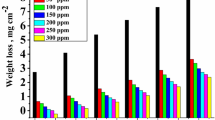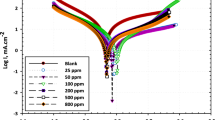Abstract
THE electrode potential of a mild steel specimen immersed in sodium chloride solutions has been measured in conditions of very rapid aeration produced by bubbling air vigorously over the specimen. Corrosion is rapid, but the potential does not fall to the values observed in conditions of moderate aeration. It rises to a maximum value that can be maintained for an appreciable time even though corrosion continues at a rapid rate. (This maximum potential must be related to the maximum rate of cathodic depolarization as limited by the rate of diffusion of oxygen across the boundary layer on the surface of the metal.) The relationships between potential, chloride concentration and surface preparation of the steel are specific and reproducible and will be described elsewhere. At lower rates of aeration, lower (less-positive) steady potentials can similarly be maintained. This method of potential stabilization was used to test the theory put forward by De1 for inhibition in neutral and acid solution. De suggested that inhibitive anions are adsorbed preferentially on metal/solution interfaces that are positive to the zero charge potential (potential of electrocapillary maximum) of the metal, that is, he suggested, on cathodic surfaces in neutral solution. Evidence for such preferential adsorption has been found by Hoar and Holliday2, by Antropov et al. 3 and others for inhibition in acid solutions; but so far as I am aware no direct evidence exists for its validity in neutral solutions.
This is a preview of subscription content, access via your institution
Access options
Subscribe to this journal
Receive 51 print issues and online access
$199.00 per year
only $3.90 per issue
Buy this article
- Purchase on Springer Link
- Instant access to full article PDF
Prices may be subject to local taxes which are calculated during checkout
Similar content being viewed by others
References
De, C. P., Nature, 180, 803 (1957).
Hoar, T. P., and Holliday, R. D., J. App. Chem., 3, 502 (1953).
Antropov, L. I., Grigor'ev, V. P., and Petrenko, A. T., Zh. prikl. Khim., 31, 1497 (1958).
Ayazyan, E. O., Doklady Akad. Nauk. S.S.S.R., 100, 473 (Chem. Abst., 49, 11533a (1955)).
“Chemistry Research 1958”, 30 (H.M.S.O., London, 1959) and unpublished results.
Brasher, D. M., and De, C. P., Nature, 180, 28 (1957).
Gilbert, P. T., and Hadden, S. E., J. App. Chem., 3, 545 (1953).
Author information
Authors and Affiliations
Rights and permissions
About this article
Cite this article
BRASHER, D. Corrosion Inhibition and the Zero Charge Potential of Metals. Nature 185, 838–839 (1960). https://doi.org/10.1038/185838a0
Issue Date:
DOI: https://doi.org/10.1038/185838a0
Comments
By submitting a comment you agree to abide by our Terms and Community Guidelines. If you find something abusive or that does not comply with our terms or guidelines please flag it as inappropriate.



